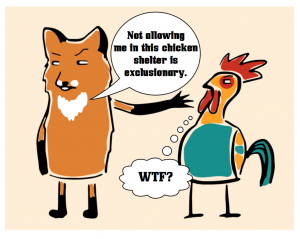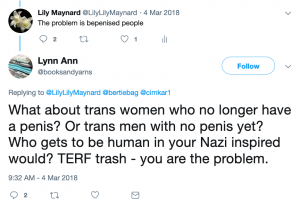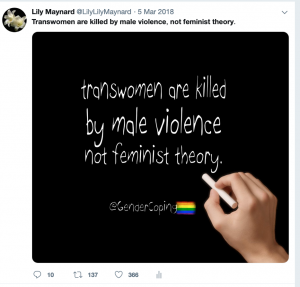
Not all foxes
There’s a specific vocabulary used in the accusations slung at gender critical women. Even people who don’t know the difference between ‘their‘ and ‘they’re‘ seem to be able to spell ‘spouting vitriol‘ and ‘spewing hateful bile’. The most common insults are ‘fucking TERF’, ‘TERF bitch’ or the slightly less aggressive, ‘shut up, TERF’. Often, just ‘TERF’ seems to be enough, although the word ‘hate’ is never far away.

TERF (as if you didn’t already know) is an acronym for ‘Trans Exclusionary Radical Feminist’. That word ‘exclusionary’ sounds pretty negative. Excluding trans people? Awful. Excluding them from what, exactly? It conjours up images of mid-20th century racism and homophobia; of ‘whites only’ drinking fountains; ‘No Irish’ job advertisements, and seaside B&Bs with ‘homosexuals not welcome here’ signs in the windows.
The thing about ‘TERF’ is that it isn’t even really ‘a thing’. Radical feminism is not trans-exclusionary, it’s MAN exclusionary. The clue is in the name.
Radical feminists – and importantly, a lot of women who would never dream of calling themselves radical feminists- want men excluded from specifically all-female spaces. We don’t want penises in women’s changing rooms, refuges, prisons; at our women’s sports clubs & events. We want men excluded from our all-women shortlists. Because once men, whether or not they’ve undergone GRS – and let’s remember that >75% of ‘transwomen’ still have a penis– make their way onto those spaces and lists they aren’t for women any more.
It’s not unreasonable to say that if men can call themselves women, the word ‘woman’ stops having any significant meaning.
‘Transwomen’- men who believe they are women- do not experience menstruation or pregnancy. They haven’t undergone female puberty. Most have been raised with male privilege in one form or another. The discrimination and assaults that they are subject to at the hands of other men are because they are, usually, perceived as men. This violence and discrimination has no place in a civilised society where everyone should be able to dress as they like and pursue whatever hobbies interest them, but it is not the concern of radical feminism because radical feminism is not about men. To say feminism should concern itself with men is like approaching the Dogs’ Trust and telling them they’re cat-haters because they aren’t looking after cats. Some might say a closer analogy would be approaching a chicken shelter and suggesting they take in wounded foxes.
Radical feminism is not ‘trans exclusionary’- it’s MAN exclusionary.
Because it’s not about men.
Transmen, on the other hand – women who believe they are men- are still the concern of feminism, whether they like it or not. They are female-bodied people, drawn to transition because the subjugation and oppression of women by our culture seems so alien to them. Many are lesbians, who although they ‘identify’ as straight men, are still affected by feminist issues such as menstruation, rape, abortion and pregnancy. They have no experience of male puberty, of wet dreams or obvious, unwanted and embarrassing pubescent erections. They have only a vague, idealised notion of what it means to be men, and are disadvantaged under patriarchy because they are still -mostly- perceived as women. Even those females who ‘pass’ as men and have undergone phalloplasty were born with XX chromosomes and socialised as girls. Most importantly, radical feminism is concerned with the oppression of women as a class and you just can’t opt out of that. Radical feminism doesn’t exclude women who call themselves ‘transmen‘ because radical feminists know that they are still women.
It’s that simple.
Transactivists will tell you that all TERFs are man-hating, right wing, religious zealots who hate gay people.
I’m only going to say this once and I’m rolling my eyes that it even has to be said. I don’t hate men. I’m very happily married to one. I know that patriarchy isn’t all fun and games; that males are more likely to be pressurised into joining gangs, stabbed to death on the streets and/or packed off to be cannon fodder in mindless wars. I know that the biggest killer for men under 45 in the UK is suicide, 75% of suicides in the UK are male, and men are three times more likely to be driven to alcoholism than women. Society considers a man who fails to ‘provide’ for his family to be a failure. Patriarchy harms men too. I know this shit. #notallmen. Not my Nigel.
Looking at men as a class however, it’s a different story. Between 2002- 2015, males were found to be the offender in over three-quarters of overall violent incidents (81%) in England and Wales. Both rape and other sexual offences (88,106) were at the highest level since the NCRS was introduced in 2002. Male violence is a huge problem.
“When I hear people say “Not All Men” this is what I think. Not all passengers in taxi cabs are thieves, but taxi drivers put up plastic screens. Passengers don’t say “Not All Passengers”. Not all teachers are paedophiles but we check their criminal records annually. Teachers don’t say “Not All Teachers”. Not all applicants for jobs are liars but we reference check them anyway. Candidates don’t say “Not All Candidates”. Not all men are rapists but women want spaces just for women… but, to this last one, men say “Not All Men”.
Nicola Williams: When I Hear People Say ‘Not All Men’
*******
“The devastating breadth of male violence against women and transwomen alike is under-reported and under-acknowledged, and the violence perpetrated by transwomen against women is flat out denied.”
Gender Apostates: ‘Male Violence is the Problem & Transwomen Commit it Too“
*******
A Swedish long-term follow up study of ‘transexual persons’ following ‘gender reassignment surgery’ came to the conclusion that transwomen maintained male patterns of violence:
“Regarding any crime, male-to-females had a significantly increased risk for crime compared to female controls, but not compared to males. This indicates that they retained a male pattern regarding criminality. The same was true regarding violent crime.”
So taking this into account, we might also want to consider that the number of transgender prisoners in England & Wales grew by 80% between 2016-2017 and that up to half of all trans prisoners may be sex offenders.
Might it, then, not be reasonable to suggest that a woman is no more- or less- safe around a transwoman than any other man.? Not that all trans-identified people are violent predators any more than all men are violent predators; not that trans people shouldn’t have the same rights and protections as anyone else. Shouldn’t actual women, the female-bodied; the ones who get pregnant and menstruate, be allowed a little privacy and spaces of their own?
If you agree with that, congratulations. You’re a TERF. Best to keep it to yourself. Shut up, TERF.
“You’re a TERF, a right wing, religious zealot who hates LGBT people.”
I don’t hate LGBT people. I’m bisexual. My eldest daughter’s a lesbian. Pretty sure middle-child is bi. Smallest is a unicorn. Next.
I’m not religious, or right-wing. I used to love Corbyn before he sold women down the river and started sucking up to the misogynistic Madigans & Bergadofs of this world. The Conservative Party has always made me feel slightly sick, a hotbed of privilege and brazen entitlement. As for organised religion, it’s the patriarchy at its worst with its cacophony of judgemental and war-mongering gods.
I don’t fantasise about a ‘Nazi-inspired world’ (sic). Just… no. Really. Stop now.

‘TERF’ has become an umbrella almost as broad as ‘TRANS’. In some circles it is the worst thing a woman can be called. Saying a man is a not woman is akin to being a Nazi, but being a Nazi is implicit in the accusation ‘TERF”.
Even describing yourself as a lesbian and same-sex attracted has been called ‘TERFy’, most notoriously by the CEO of Stonewall, Ruth Hunt.
Even detransitioned men get called TERFs if they don’t use the ‘correct’ language.
Over and again we are told that TERFs are responsible for the deaths of trans people. If I had 50p for every time I was told that there’s blood on my hands because I won’t say a man is a woman, I could buy myself a mooncup in every colour of the rainbow. Feminists are not the problem. Violent men are the problem.

According to the transrespect site, between 2008 and 2016, eight trans people were killed in the UK. (One of these turned out to not be dead, another to be a suicide/accidental death.) So six trans-IDd people (all men) were killed in those 8 years. Those deaths are a sad and tragic waste of life. Nothing seems to suggest that any of them were killed specifically for being trans: one of them was killed by a trans-identified man. Unsurprisingly, none of them were killed by women. You can read a post on this, with citations, here.
Fair Play for Women examines statistics that suggest that trans people are no more likely to get murdered than anyone else here.
At a time when Bristol Students’ Union has voted for a ban preventing TERF groups from holding events at the university‘, when women are punched in the face for wanting to discuss gender ideology, when meetings must be held in secret, and Millwall football ground – surely no stranger to controversy – has backed out of their agreement to host the next ‘We Need to Talk’ event- all accompanied by cries of ‘TERF’: it seems that ‘the T-word’ has become a magic spell for shutting women up.
“I did warn them about transactivists.” says Venice Allan, of the decision by Millwall. ” I think they thought I was being grandiose.’
Grandiose? Far from it. It seems as if transactivists can say whatever they like to and about women whilst we are denied meeting places, intimidated, doxxed, removed from social media, kicked out of political parties and reported to the police just for expressing the opinion that transwomen are men and that the transitioning of children is abusive.
So who exactly is a TERF? Outside of the world of activism and social media it seems that TERFs are everywhere. The old bloke in the flat cap outside the pub? He’s a TERF. The young mum coming home with her shopping? TERF. Your bus driver? She’s one too. The beggar outside McDonalds; the woman walking her dog in the park. Yup, them as well. They’re all TERFs. They just don’t know it yet.

We now are moving into a culture where violence against TERFs is condoned because they are such evil Nazis. I could post hundreds of examples of tweets calling for violence against ‘TERF’ women. Instead I’ll link to Meghan Murphy’s excellent article, ‘TERF isn’t just a slur, it’s hate speech’.
if Bristol goes ahead, it will not be the first UK university to ‘ban the TERF’. Julie Bindell wrote in 2015 about the ‘campus craze’ of excluding outspoken women from speaking at events. Tiers 4 and 5 of this ‘banned by trans‘ post deal with the (mostly) women who have been banned from speaking, writing and performing because of their TERF ideology. Pussy hats are TERFy, AF. So is The Vagina Monologues. Check out Terry Mcdonald’s article in The New Statesman, ‘Are You Now or Have You Ever Been a TERF?
In 2016, Juno Dawson wrote an article for GLAMOUR magazine entitled ‘Call Yourself a Feminist?’ In it he wrote about who could be called a feminist and who couldn’t. (I’ll give you a clue – TERFs were out). Fast forward to 2018 and Munroe Bergdorf is doing the same thing with his article in GRAZIA ‘Women are Getting Feminism all Wrong’.
Exclude men from your feminism & you’re not a feminist. Men say so.
Don’t want men in the women’s changing rooms at your local swimming pool? TERF.
Don’t want boys changing next to your daughter before PE at school? TERF.
Don’t think men should advise political parties on women’s issues, or stand as Women’s Officers? TERF.
Don’t think men should play on women’s and girls’ sports teams? TERF.
Don’t think men should win awards designated for women or take places on women’s shortlists? TERF.
Worried about male-pattern violence? TERF.
Don’t think a man becomes a woman just because he says so? TERF, TERF.
Don’t believe there’s any such thing as a lesbian with a penis? TERF. TERF. TERF.
Shut up, TERF.
Shut up.
SHUT UP.





 “We believe that sex based violence against women still exists …
“We believe that sex based violence against women still exists …  “I joined the fire brigade in 2005.
“I joined the fire brigade in 2005. 







